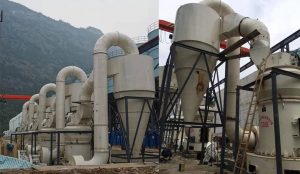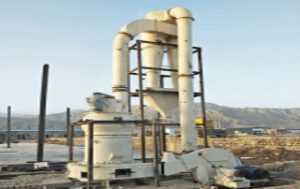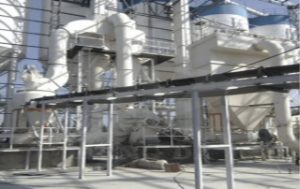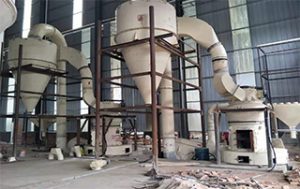What is barite
Barite is the most common mineral of barium, and its component is barium sulfate. Produced in low temperature hydrothermal veins, such as quartz-barite veins, fluorite-barite veins, often with galena, sphalerite, chalcopyrite, cinerar, etc. Barite deposits in Hunan, Guangxi, Qinghai and Jiangxi provinces of China are mostly giant hydrothermal single mineral veins. Barite can also be produced in sedimentary rocks, appearing as nodules, mostly in sedimentary manganese deposits and shallow sea muddy and sandy sedimentary rocks. In the residual clay overburden of weathered residual deposits, it often forms into nodules and masses.
Barite is an important non-metallic mineral material, which has a wide range of industrial applications.
1, drilling mud weighting agent: in some oil Wells and gas Wells drilling, the general use of drilling mud, clay proportion is about 2.5, the proportion of water is 1, so the mud proportion is low, sometimes mud weight can not balance with underground oil and gas pressure, resulting in blowout accidents. In the case of high underground pressure, it is necessary to increase mud gravity, adding barite powder into mud is an effective measure to increase mud gravity. Do the barite drilling mud with the general fineness of 325 mesh or more, such as barite fineness is not enough is easy to precipitate. Drilling mud barite should be more than 4.2, BaSO4 content is not less than 95%, soluble salt is less than 1%.
2, zinc barium white pigment: zinc barium white is a commonly used high-quality white pigment, can be used as paint, painting pigment raw material. Barium sulfate is heated and reduced to barium sulfide (BaS) with reducing agent. The mixture of barium sulfate and zinc sulfide (BaSO4 70%, ZnS 30%) obtained by reaction with zinc sulfate (ZnSO4) is zinc barium white pigment. The barite for preparation of zinc-barium white should contain more than 95% BaSO4 and no visible colored debris.
3, all kinds of barium compounds: barite as raw material can produce barium oxide, barium carbonate, barium chloride, barium nitrate, precipitated barium sulfate, barium hydroxide and other chemical raw materials.
Chemically pure barium sulfate is the standard for measuring whiteness; Barium carbonate is an important raw material of optical glass. It introduces BaO into the glass to increase the refraction rate of the glass and improve other optical properties. In ceramics used to prepare glaze; Barium chloride is an agricultural pesticide; Barium nitrate is used in the firework and glass industries; Barium permanganate is a green pigment.
4. Barite for packing industry: in the paint industry, barite powder packing can increase the thickness, strength and durability of the paint film. Zinc-barium white pigment is also used to make white paint, which has more advantages than lead white and magnesium white when used indoors. Barite used in paint industry requires enough fineness and high whiteness.
Paper industry, rubber and plastic industry also use barite as filler, this filler can improve the hardness, wear resistance and aging resistance of rubber and plastic.
Rubber, paper barite filler general requirements BaSO4 is greater than 98%, CaO is less than 0.36%, do not contain magnesium oxide, lead and other components.
5. Mineralizer for cement industry: the incorporation of barite and fluorite composite mineralizer in cement production has obvious effect on promoting the formation and activation of C3S, and the clinker quality has been improved. The cement strength can be increased by 20 ~ 25% in early stage and 10% in late stage, and the clinker firing temperature is reduced from 1450℃ to 1300±50℃. When the barite content is 0.8 ~ 1.5%, the effect is the best. In the production of white cement, the sintering temperature is reduced from 1500℃ to 1400℃, the content of free CaO is low, and the strength and whiteness are improved by using barite and fluorite composite mineralizer. Adding proper amount of barite into raw cement with coal gangue as raw material can greatly improve the cement strength with low clinker saturation ratio, especially the early strength, which provides a beneficial way for the comprehensive utilization of coal gangue and the production of low calcium, energy saving, early strength and high strength cement.
6, anti-ray cement, mortar and concrete: the use of barite with X-ray absorption performance, barite made of barium cement, barite mortar and barite concrete, used to replace metal lead plate shielding nuclear reactors and the construction of scientific research, hospital anti-x-ray buildings.
Barium cement is made of barite and clay as the main raw materials, and the clinker composed of barium silicate as the main mineral is obtained through sintering, and then an appropriate amount of gypsum is added to grind together. The specific gravity is higher than the general Portland cement, up to 4.7 ~ 5.2. Strength grade is 325 ~ 425. Due to the high ratio of barium cement, it can be mixed with heavy aggregate (such as barite) to make uniform and dense X-ray proof concrete.
Barite mortar is a kind of mortar with large bulk density and blocking effect on X-ray. It is generally required to use Portland cement with low heat of hydration. The cement: barite powder: barite sand: coarse sand mixing ratio is 1∶0.25∶2.5∶1. Barite concrete is a kind of concrete with large bulk density and X-ray shielding ability. The cementing material generally uses Portland cement or high aluminum cement, barium cement, strontium cement and other special cement with low heat of hydration. Portland cement is the most widely used. The mixture ratio of cement: barite crushed stone barite sand: water is 1∶4.54∶3.4∶0.5. 1:5.44:4.46, 0.6; 1:5:3.8:0.2 3 kinds.
The barite that does prevent ray mortar and concrete, BaSO4 content should not be less than 80%, the impurity such as gypsum, pyrite, sulfide and sulfate that contains among them must not exceed 7%.
7. Road construction: A mixture of rubber and asphalt containing about 10% barite has been successfully used in parking lots and is a durable paving material. The tyres of heavy road construction equipment have been partially filled with barite to increase the weight and facilitate tamping of the fill area.
8, other: barite and oil after blending coated on the fabric manufacturing tarpaulin; Barite powder is used to refine kerosene; In the pharmaceutical industry as gastrointestinal contrast agent; Can also make pesticides, leather, fireworks and so on. In addition, barite also used to extract metal barium, used as television and other vacuum tube getter, binder. Barium is made into alloys with other metals (aluminum, magnesium, lead, calcium) for bearing manufacture.
Barite grinding process
Stage 1: crushing
The feeding fineness (less than 30mm) of barite bulk material crushed by crusher can enter the mill.
The second stage: material grinding
After crushing, small pieces of heavy calcium carbonate are sent to the raw material bin by the elevator, and then sent into the grinding room of the mill uniformly and quantitatively by the vibration feeder. After grinding, the grinding materials are graded by the analysis machine. Those whose fineness meets the specifications flow into the big cyclone collector with the wind. After collection, the fineness is discharged into the finished product through the discharge valve.
Stage 3: Storage or packaging of finished products in cans
The finished products discharged from the discharge valve are transported to the finished product tank for storage by pneumatic conveying equipment.
The finished products discharged from the unloading valve are packaged in small packages by double-mouth packaging machine.
③ The finished products discharged from the unloading valve are packed by tons of chartered aircraft.









